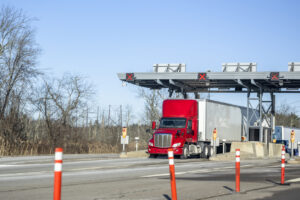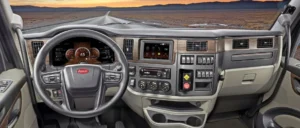Those who were expecting a resolution to the issue of side underride protection were disappointed in the June 18 report from the National Highway Traffic Safety Administration’s (NHTSA) Advisory Committee on Underride Protection.
While the report included recommendations to the NHTSA, it included a minority report that claimed those recommendations don’t meet the agency’s directive to the committee to provide “written consensus advice.” The result, unsurprisingly, is that more discussion will be needed.
The creation of the ACUP began with the Biden administration’s Bipartisan Infrastructure Law in 2022 and was made a part of the U.S. DOT’s 2022 National Roadway Safety Strategy.
Selected for the 16-member committee were representatives from families of underride crash victims, truck safety organizations, motor vehicle crash investigators, law enforcement, labor organizations, motor vehicle engineers, the insurance industry, vehicle manufacturers and, finally, motor carriers.
The mission
The ACUP was charged with researching strategies to reduce the number of underride accidents and the fatalities and injuries that occur and then presenting their recommendations to the Department of Transportation. Underride crashes involving the front, rear and sides of tractors and trailers were considered separately.
The recommendations
The ACUP report recommended that all new trucks and trailers that have “open spaces” along the sides be equipped with side underride guards that can prevent passenger vehicles from going under at speeds up to 40 mph. Additionally, the committee recommended that all trucks and trailers manufactured after 1998 be retrofitted with the same type of guards.
ACUP also presented a recommendation that a new cost-benefit analysis that includes pedestrians, bicyclists and motorcyclists, categories that were omitted from the previous study.
For rear underride protection, ACUP recommended tougher standards for rear impact guards on new vehicles and retrofits for older ones, as well as stronger standards for conspicuity tape.
The minority report
The minority report issued concurrently disagreed with the findings of the majority, mostly on the basis of whether simple majority votes by the committee constituted a “consensus,” as required by NHTSA directive. Objections were raised about “preconceived biases” by some committee members, as well as claims that the committee ignored materials and technical presentations made by members. At the same time, the group asserts, materials that were not approved by the committee were included in the final report.
The minority group advised that the U.S. Secretary of Transportation should commission “comprehensive, evidence-based studies to determine the scope of the underride problem, the ability to solve it and the costs of doing so” before developing recommendations.
One of the concerns raised by the minority is the possibility of unforeseen consequences. Side underride guards would increase the dimensions of trailers and trucks, creating more surface that could be involved in collisions. Todd Spencer, president and CEO of Owner-Operator Independent Drivers Association (OOIDA) agreed in a letter to transportation committee members in both houses of Congress.
“OOIDA has discussed operational challenges regarding rail crossings, loading docks, and low ground clearances with Congress, as well as equipment damage resulting from curbs, roundabouts, speed bumps, and other highway features. These are all discussed at length within ACUP’s minority report,” he said.
Additional weight of side underride guards could result in structural damage to trailers and would impact load capacity, possibly resulting in more trucks needed.
The reaction
Dave Heller, senior vice president of safety and government affairs for the Truckload Carriers Association (TCA), weighed in on the topic.
“Certainly, I believe if it moves forward at this point, it would be one of the most expensive rule makings to be bestowed upon the industry ever,” he said. “So, in saying that there are certainly needs, they need to handle this with ‘kid gloves’ and make sure all the i’s are dotted and t’s crossed”.
Hailey Betham, TCA’s manager of government affairs, agrees.
“The trucking industry does adopt technologies of all kinds to increase safety on our nation’s highways. However, I think there are other technologies besides side underride guards that could have a greater impact,” she said. “We need more research and testing to see what the impact really is.”
Weight is always a consideration when adding equipment to trucks or trailers and the ACUP minority mentioned their concern.
“The weight would be an additional 800 pounds or so, and trucks are allowed to weigh no more than 80,000 pounds,” Betham said. “So, that does that mean that you have to haul less freight in order to use this technology?”
Heller has another view of side underride guards.
“I think it’s worth noting that side underride guards are not an ‘accident-prevention’ piece of technology, which is what industry is really interested in. We don’t want to justify the accidents we want to stop them from happening altogether,” he said.
Clearly, the trucking industry has already absorbed substantially increased costs for technology to increase safety and efficiency. A large percentage of new trucks come equipped with advanced driver assistance systems (ADAS), such as adaptive cruise control, lane departure and collision-mitigation systems.
Carriers have absorbed increased costs for emissions control, too, and are preparing for another substantial increase with 2027 model-year trucks.
Whether the DOT or one of its sub-agencies will act on the recommendations of the ACUP remains to be seen.
“I believe that there will be more discussion,” Heller said. “I think they constituted the committee for another year, which means the dialogue will be ongoing to make sure that this is entirely vetted to its utmost, and then go from there.”
Until ACUP recommendations are formed into law, TCA plans to continue the conversation in Washington.
“It’s certainly one of those situations that we will talk about on Capitol Hill,” Heller said. “We’ll be explaining what the underride world looks like and how new technology can supplant the discussions on side underride guards — if we go that route — but at the same time, we will not just accept flawed guidance under the auspices of underride or anything else.”
The November elections may have an impact on the issue as well, as the makeup of Congress, as well as the occupant of the White House, will undoubtedly change. Whether those changes end up favorable to the ACUP majority recommendations or those of the minority group may be decided in precincts across the nation.
Cliff Abbott is an experienced commercial vehicle driver and owner-operator who still holds a CDL in his home state of Alabama. In nearly 40 years in trucking, he’s been an instructor and trainer and has managed safety and recruiting operations for several carriers. Having never lost his love of the road, Cliff has written a book and hundreds of songs and has been writing for The Trucker for more than a decade.














